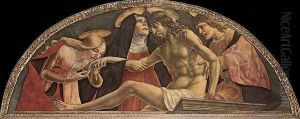Lorenzo di Alessandro Da Sanseverino Paintings
Lorenzo di Alessandro da Sanseverino was an Italian painter active during the Renaissance period, born around 1460 in the Marche region of Italy. Not much is known about his early life, but he is believed to have been part of the artistic movement that flourished in the Marche during the late 15th and early 16th centuries. Lorenzo's work is often associated with the school of painting that developed in the city of San Severino Marche, where he took his name from, indicating either his birthplace or the primary location of his artistic activity.
Lorenzo's style is characterized by its adherence to the principles of the early Renaissance, emphasizing clarity of form, balanced compositions, and a careful approach to perspective. His paintings often feature religious subjects, a common theme for the period, executed with a depth of emotion and a delicate handling of color and light. This approach aligns him with the broader trends of Italian Renaissance art, though he also exhibits certain regional characteristics that distinguish his work within the context of Marche's artistic output.
Despite his talent, Lorenzo di Alessandro da Sanseverino remains a relatively obscure figure in art history, overshadowed by the more famous luminaries of the Italian Renaissance. However, his contributions to the Marche school of painting and his role in the dissemination of Renaissance artistic values beyond the major centers of Florence, Rome, and Venice are increasingly recognized by scholars. His works can be found in several Italian churches and museums, offering valuable insights into the diversity and richness of Renaissance art across Italy.
Lorenzo's career was relatively short, with his death occurring around 1503. The exact circumstances of his demise are not well documented, which is not uncommon for artists of his time. Despite the brevity of his life and career, Lorenzo di Alessandro da Sanseverino's body of work provides a fascinating glimpse into the regional variations of Italian Renaissance art, showcasing the interplay between local traditions and the broader, pan-Italian Renaissance movement that transformed Western art.
